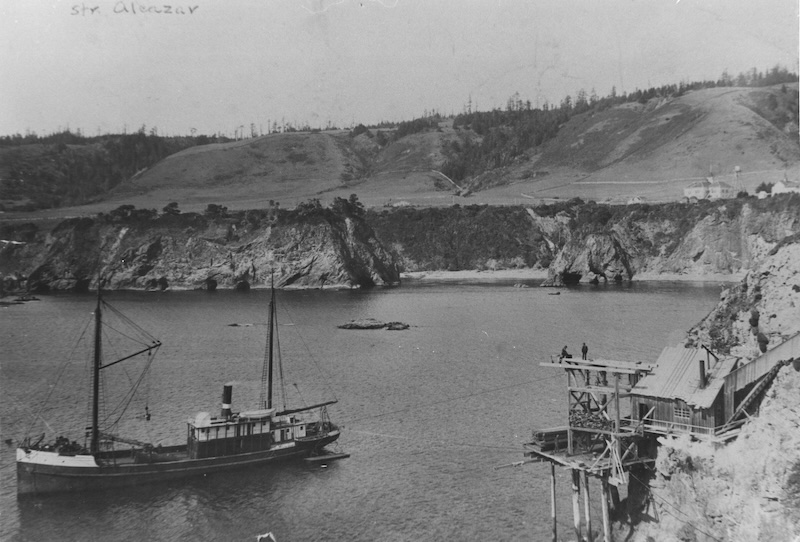The Kelley House Museum’s current exhibit, Nathaniel Smith: Mendocino’s First African American Resident, was funded by a grant from California Humanities. The grant supported research by Alexander Wood into the life of Nathaniel Smith. Below is an excerpt from Wood’s paper on Smith’s arrival in, and the naming of, Cuffey’s Cove.
Smith’s arrival on the Mendocino coast on a whaling ship with a Sausalito crew is based at least partly on legend. More accurately, those at the scene embroidered the story as they aged. All accounts begin with the group landing or settling about 15 miles south of Mendocino at a bay just north of today’s Elk referred to as Cuffey’s Cove. Lyman Palmer’s 1880 History of Mendocino County reports two possible origins for the cove’s name, both stemming from the groups’ arrival.

Steam schooner Alcazar loading lumber in Cuffey’s Cove, c. 1900. (Gift of Flora Buchanan)
The first origin story says that “cuffey” was a word used to describe a bear. Grizzly bears were prevalent in the area at the time, as were black bears. The first version of the cove’s naming is recalled by Charles Fletcher’s granddaughter, Elsie Farnsworth, who told the story in a 1975 interview, over a century after Fletcher, Smith, and the rest of the Sausalito crew reached Mendocino. Farnsworth stated that her grandfather “sailed in close along the Mendocino Coast. He went close to what is now Cuffey’s Cove. There the crew said, “Oh, Captain! A big cuffey! A big cuffey!” That was a bear, it was climbing up the bank. And so Cuffey’s Cove got its name from the bear.” Skiffington tells almost the same story, but in his account, the group found ten or twelve grizzly bears on the coast. He recalls being told that Fletcher, “called a bear a Cuffy. He said to the others: ‘This is a regular cuffy’s cove.’ So the place was named Cuffey’s Cove.”
Other accounts include a bear attack as a part of the story. For example, Smith’s obituary in the San Francisco Chronicle states that he and Francisco Faria named Cuffey’s Cove “on account of a fight which they had with a grizzly bear in which Frank was nearly chewed to death before he could kill the brute with his hunting knife.” The obituary further states, “the bear was named ‘Old Cuffey,’ from the peculiar manner with which he used his paws in fighting.” Dorothy Bear and Beth Stebbins also report that Faria “was attacked and badly mauled by a wounded bear that left him with a deformed arm.” Faria’s obituary tells a similar account, stating that near Cuffey’s Cove, Faria was attacked and bitten by a bear.
Thompson reports that Faria “once told the story of his mauling by the bear to young Jim Skiffington,” but Smith warned Skiffington that, “Portuguese Frank was the biggest liar in the world, but because he was such a little man and talked so much and so long, at least half of what he said had to be true.”
However, the other possible origins of the term “cuffey” should be considered, and both of them focus on Nathaniel Smith. Subsequent settlers used “cuffey” as a racial slur that referred to Smith’s residence near the cove. Cuffee, Cuffey, or Coffey is a first name and surname in African-American culture, believed to be derived from the Akan language. According to Junius Rodriguez. this was one of the most common male names of West African origin that was retained by some American slaves.
Historian John W. Blassingame confirms that “cuffee” was used as a derogatory term by whites to refer to African Americans. No less a personage than Jefferson Davis, then a U.S. senator from Mississippi who later became the President of the Confederate States, said that the discussion of slavery in the Dred Scott v. Sandford case was merely a question of “whether Cuffee should be kept in his normal condition or not.”
Jonathon Green’s Dictionary of Slang includes three definitions for “cuffy”—a derogatory term for a black person, a bear, or a gullible person. Palmer first considered that “cuffey” referred to a bear, but that “the other legend…is to the effect that the early settlers found a negro here when they came to the place, whom they donned with the title of Cuffey.” Palmer likely is referring to Smith, the first known African American settler in the county.
The Nathaniel Smith exhibit closes on May 27th. The Kelley House Museum is open from 11AM to 3PM Thursday through Monday. Visit the Kelley House Event Calendar to schedule a Walking Tour of the Historic District.